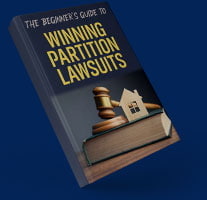Baldwin Park Partition Lawyers
Baldwin Park is a city in the San Gabriel Valley in Los Angeles. Baldwin Park is home to the first In-N-Out burger stand, which opened on October 22, 1948. According to Redfin, in March 2024, the median sales price was $674,000 and homes stay on the market for 60 days. Baldwin Park residents who own real estate may face disputes with co-owners. There are at least four different instances where an Oakland Partition Lawyer can be helpful:
- Boyfriend-Girlfriend co-ownership of property;
- Sibling-Sibling co-ownership of property;
- Parent-Child co-ownership of property; and
- Investor-Investor co-ownership of property;
What is a Partition Action?
A partition action occurs when there are two or more title holders to a piece of property, and these title holders are unable to reach an agreement on splitting the subject property. Typically, a litigant brings a partition action to have the court force the sale of or split the subject property. Therefore, when a piece of personal property is concurrently owned by several people, one of the owners may bring a partition action to have the court divide the subject property. In the past, California courts have partitioned not only real estate but also, shares of stock, cash, and businesses.
Generally, an action for partition can be brought forth by a co-owner of real property and a co-owner of personal property. Notably, a court can partition not only real property or real estate but also personal property of any kind. (CCP § 872.230(a).) The best Baldwin Park Partition Lawyer will be able to share information on this process with you.
What are the steps in a Partition Action?
First, a partition action is filed. A partition action can be filed if one co-owner of real property or a piece of real estate wishes to sell the property or piece of real estate in question but the other co-owners or co-tenants do not wish to sell their ownership rights.
Second, the court may appoint a court referee to oversee the sale of the property in question. The sales procedure includes that all parties agree to the terms and conditions of the sale in writing. If the parties can not agree, as partition actions are usually very contested issues, then the referee that the court appointed may recommend terms and conditions to the court. Then the court will hold a hearing to decide whether or not to accept those terms and conditions.
Third, in California, the property’s value will be appraised via a third party or another property appraisal with no ties to any of the parties. While this is not required in all states, it is recommended to make sure that all parties are on the same metaphorical page as to the potential sale proceeds of the property in question.
Fourth, the referee will conduct the sale in the method most agreeable to all of the party’s goals. This can be via a public auction or a private sale. Regardless of the specific method of partition by sale, the court will determine if the sale was “fair.” If it is decided that the property’s sale proceeds had a lack of proper notice, the sale amount is not within reasonable the value of the property, or if the proceeds were unfair- the court would rule that the property will be up for sale again.
Lastly, the court will order that the proceeds of the sale, minus any court litigated or approved offsets or costs, will be distributed equitably amongst all of the co-owners or people with interest in the property. A top Baldwin Park Partition lawyer will be familiar with the process.
Can You Recover Attorneys’ Fees in a Partition Action?
A partition action can always be resolved informally at any time prior to the first day of trial, or entry of judgment. In fact, in numerous instances, just filing the partition itself leads the other party to seek a resolution between them. We always encourage the parties to talk throughout every phase of the process, as that can lead to the best outcomes for everyone.
From our perspective, every piece of litigation is just part of a larger “negotiation.” In any negotiation, the party who has the best leverage is usually able to achieve a more favorable outcome. The lawsuit provides the client with more leverage because they have more options available to them than without the prospect of a resolution from a judge. As such, all that a lawsuit does is provide one party with more leverage in the negotiation about how to resolve the dispute. For this reason, the best way to informally resolve a dispute is to combine discussions with active litigation, so that the matter can be quickly resolved without unnecessary expense. Throughout the process, our attorneys are in touch with our clients about their options and the prospects for informal resolution through mediation or negotiation. A knowledgeable Baldwin Park Partition Attorney will be able to give you good advice on these issues.
What Are Claims for Contribution?
Under the law, a property owner can make a claim for contribution for anything that they have expended for the common benefit of all the parties as it relates to their jointly-owned property. Code of Civil Procedure section 874.410 states that “the court may, in all cases, order allowance, accounting, contribution, or other compensatory adjustment among the parties according to the principles of equity.” For example, the credits can include expenditure in excess of the co-tenants fractional share for necessary repairs and improvements that enhance the value of the property. (Wallace v. Daley (1990) 220 Cal.App.3d 1028, 1035-1036.) Similarly, payments for interest, taxes, and insurance made by any co-tenant could be the subject of a reimbursement claim. (Hunter v. Schultz (1966) 240 Cal.App.2d 24.) An experienced Baldwin Park Partition Attorney will be intimately familiar with these matters.
A Partition Case Study: Jennings v. Jennings (2023)
Some partition cases may arise due to underlying matters such as financial elder abuse or fraudulent concealment. The elements of a cause of action for financial elder abuse are: (1) defendant took, hid, appropriated, obtained, or retained plaintiff’s property; (2) plaintiff was at least 65 years old or a dependent adult at the time of conduct; (3) the defendant took, hid, appropriated, obtained or retained plaintiff’s property for a wrongful use, or with the intent to defraud or by influence; (4) the plaintiff was harmed; and (5) the defendant’s conduct was a substantial factor in causing plaintiff’s harm.(Welf. & Inst. Code, § 15610.30). The following paragraphs discuss how the court determines the parties’ ownership interests and awards damages when there are additional issues such as financial elder abuse involved in Jennings v. Jennings (2023) WL 8947088.
In Jennings, Margaret L. Jennings brought suit against her children, Teresa and Montoya Jennings and an attorney, Lisa Collins- Williams accusing them of stealing her house through a quitclaim deed. Margaret also sued for financial elder abuse, fraud, negligent misrepresentation, professional negligence, cancellation of instrument, conversion, and trespass to chattels. Teresa and Montoya filed a cross- complaint for partition and quiet title. In 2019, upon Teresa’s request, Lisa drafted and instructed Margaret to sign the quitclaim deed that transferred title to the Property from Margaret to Teresa and Montoya.
At trial, Margaret claimed that she expressed to Lisa her intent to distribute her assets after her death. However, Margaret argued that she was unaware that the document would immediately transfer ownership. In July 2020, unaware of the deed, Margaret, through another attorney, Evelyn Gillespie, had a grant deed prepared transferring the house to a living trust for herself. Only then, Margaret came to know that she no longer owned the house. When asked, Lisa told Margaret that she needed to talk to her family and gave no further responses.
Margaret further claimed that Teresa and Montoya deprived her of access to the house, denied her access to her car, and her bank accounts after the transfer. She further alleged that Teresa added herself to Margaret’s bank account without her knowledge, transferring funds to Teresa’s personal account. Margaret argued that when went to the bank, to file a fraud claim, Montoya was present and yelled at her to go home threatening to not return her walker if she did not comply.
However, the bank reversed the transfer. Montoya testified that he had gone to the bank to prevent Margaret from doing anything irrational and that in October 2019, Margaret notified him that he had been put on the Property deed. Teresa testified having done everything as per Margaret’s wish with regard to the Property and stated that she transferred money from Margaret’s bank account to prevent anyone else from fraudulently spending it. Margaret’s other daughter, Denise Washington testified that Teresa and Montoya refused to return the house to Margaret upon her request.
Lisa denied telling Margaret that the paperwork would be completed at a later time. She further stated that Teresa wanted to wait for her mother to pass before recording it despite Lisa’s advice to record it immediately. However, she testified that after Margaret tried to transfer the house to her living trust, Teresa, recorded the deed in September 2020. Lisa had also drafted a letter to Band of America, stating that Teresa had a power of attorney for Margaret. A notary testified during the trial that she had notarized Margaret’s signatures on a power of attorney and a quitclaim deed in Lisa’s office in October 2019.
The jury found that Teresa and Lisa were liable to Margaret for financial elder abuse and fraudulent concealment, finding Teresa liable to Margaret for conversion/trespass to chattels. It awarded her $1,500 for past economic loss for medical expenses and $5,000 for other past economic loss, $15,000 for pain and suffering, $536,500 against Teresa and Lisa in past economic damages and finding them liable for fraudulent concealment, $15,000 in past noneconomic loss including pain and mental suffering and $15,000 in future noneconomic loss including physical pain and mental suffering. In addition, finding Teresa liable for conversion and trespass to chattels, it awarded $4,000 in damages to Margaret and $10,000 in punitive damages.
The trial court reduced the damage award for fraudulent concealment cause of action to $0 as it found that the jury had awarded the award as compensation for the loss of the house, which would be returned to Margaret and cancelled the quitclaim deed. The court granted Margaret $6,000 in economic damages and $15,000 in non-economic damages against Teresa and Lisa. On the conversion and trespass to chattels cause of action, the court awarded her $4,000 in damages against Teresa. It also awarded Margaret $10,000 in punitive damages against Lisa. The court also awarded Margaret a total of $123,206.50 in attorney’s fees. Teresa appealed.
The California Second District Court of Appeal affirmed the decision in part and reversed it in part. Teresa contended on appeal that substantial evidence does not support jury’s verdict, the attorney’s fees should not have been awarded and that the amount awarded was excessive. The court stated that when assessing the sufficiency of evidence for a jury’s decision, the court examines the records in the light that is most favorable to the prevailing party. (Markow v. Rosner (2016) 3 Cal.App.5th 1027, 1045.) Teresa argued that substantial evidence does not support the finding that she took Margaret’s property for wrongful use or with intent to defraud or that Margaret suffered $6,5000 in economic damages. The court of appeals evaluated all elements of a cause of action for financial elder abuse.
The court ruled that there was no dispute that Teresa and Montoya acquired the Property via a quitclaim deed. The court found Margaret’s intentions to transfer the house title after death credible, alongside her lack of knowledge about the quitclaim deed. Considering evidence like Margaret’s later recording of the house to her living trust, the court inferred she did not intend to transfer the property via quitclaim deed. The court further held that Teresa’s role in preparing the quitclaim documents, presence during signing, and recording the deed after Margaret’s action led the jury to reasonably suspect fraud. The court upheld the jury’s decision that Teresa wrongfully used the house and intended to defraud Margaret.
Furthermore, the court agreed with the jury that Teresa was liable for fraudulent concealment by not disclosing the title transfer to Margaret through the quitclaim deed. Regarding the trespass to conversion and trespass to chattel, Teresa argued the jury award of $4,000 in damages was unjustified as she returned the amount. The court found that since Teresa denied Margaret access to her car, her car keys, and her household items, it interfered with her right to possession, entitling her to damages sufficient to compensate for the impairment or loss of use of the property, justifying $4,000 in damages. The court also concluded that the trial court did not abuse its discretion regarding the amount of attorney’s fees awarded.
Thus, the court reversed the portion of judgment awarding $6,500 in economic damages for financial elder abuse, due to lack of showing as to how Margaret suffered the specific loss, and affirmed the remainder, holding that both parties would bear their own costs on appeal.
How the Underwood Law Firm Can Help
As seen above, various claims related to disputes over ownership of a property may arise, each dependent on the specific conditions that give rise to such claims, especially in situations such as potential financial elder abuse. If you are considering partition as an option, or find yourself defending one, then you may benefit from good legal advice on the topic. Please contact Underwood Law Firm, P.C., for an initial consultation.









